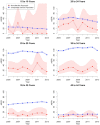General and age-specific fertility rates in non-affective psychosis: population-based analysis of Scottish women
- PMID: 35648175
- PMCID: PMC9845143
- DOI: 10.1007/s00127-022-02313-y
General and age-specific fertility rates in non-affective psychosis: population-based analysis of Scottish women
Abstract
Purpose: Women diagnosed with non-affective psychosis have a lower general fertility rate (GFR) and age-specific fertility rate (ASFR) than women in the general population. Contemporary data on GFR in this group remain limited, despite substantive changes in prescribing and management. We calculated contemporary estimates of the GFR and ASFR for women diagnosed with non-affective psychosis compared with the general population of women without this diagnosis.
Methods: A population-based design combined routinely collected historical maternity and psychiatric data from two representative areas of Scotland. Women were included from the NHS Grampian or Greater Glasgow and Clyde areas and were aged 15-44 between 2005 and 2013 inclusive. The 'exposed' group had a diagnosis of non-affective psychosis (ICD-10 F20-F29) and was compared to the general population of 'unexposed' women in the same geographical areas.
Results: Annual GFR between 2005 and 2013 for women with non-affective psychosis varied from 9.6 to 21.3 live births/1000 women per year in the exposed cohort and 52.7 to 57.8 live births/1000 women per year in the unexposed cohort, a rate ratio (RR) of 0.28 [p < 0.001; 95% CI (0.24, 0.32)]. ASFR for all 5-year age groups was lower in the exposed cohort than amongst unexposed women.
Conclusion: We highlight continued low fertility rates in women with a diagnosis of non-affective psychosis, despite widespread availability of prolactin-sparing atypical antipsychotics. Accurate estimation of fertility rates remains crucial in developing needs-matched perinatal care for these women. Methodological improvements using routine datasets to investigate perinatal mental health are also urgently needed.
Keywords: Antipsychotics; Fertility; Psychotic disorders; Schizophrenia; Women.
© 2022. The Author(s).
Conflict of interest statement
AM is a member of the steering group for the NHS Scotland Perinatal Mental Health Managed Clinical Network. They receive no payment or this. There are no other conflicts of interest to declare from the authors.
Figures


Similar articles
-
The general fertility rate in women with psychotic disorders.Am J Psychiatry. 2002 Jun;159(6):991-7. doi: 10.1176/appi.ajp.159.6.991. Am J Psychiatry. 2002. PMID: 12042188
-
Fertility trends of women with serious mental illness in the United Kingdom 1992-2017: A primary care cohort study using the clinical practice research datalink.J Affect Disord. 2020 May 15;269:141-147. doi: 10.1016/j.jad.2020.03.037. Epub 2020 Mar 20. J Affect Disord. 2020. PMID: 32250867
-
Temporal trends in general and age-specific fertility rates among women with schizophrenia (1996-2009): a population-based study in Ontario, Canada.Schizophr Res. 2012 Aug;139(1-3):169-75. doi: 10.1016/j.schres.2012.05.010. Epub 2012 Jun 1. Schizophr Res. 2012. PMID: 22658526
-
Risks and benefits of psychotropic medication in pregnancy: cohort studies based on UK electronic primary care health records.Health Technol Assess. 2016 Mar;20(23):1-176. doi: 10.3310/hta20230. Health Technol Assess. 2016. PMID: 27029490 Free PMC article. Review.
-
Prenatal and perinatal risk and protective factors for psychosis: a systematic review and meta-analysis.Lancet Psychiatry. 2020 May;7(5):399-410. doi: 10.1016/S2215-0366(20)30057-2. Epub 2020 Mar 24. Lancet Psychiatry. 2020. PMID: 32220288
References
MeSH terms
Substances
Grants and funding
- MR/S035818/1/MRC_/Medical Research Council/United Kingdom
- NHS Research Scotland Career Research Fellowship/NHS Research Scotland
- Grant CZH/4/951/Chief Scientist Office, Scottish Government Health and Social Care Directorate
- MC_PC_MR/R01910X/1/MRC_/Medical Research Council/United Kingdom
- CGA/19/13/CSO_/Chief Scientist Office/United Kingdom

